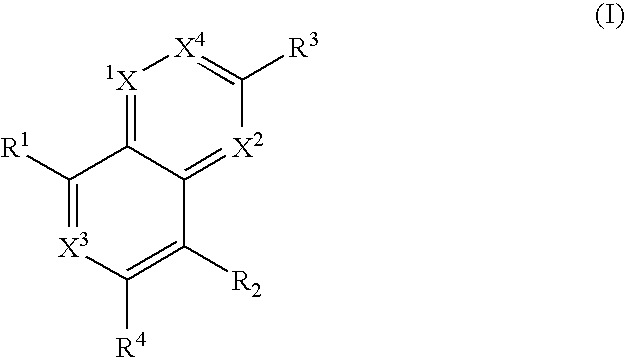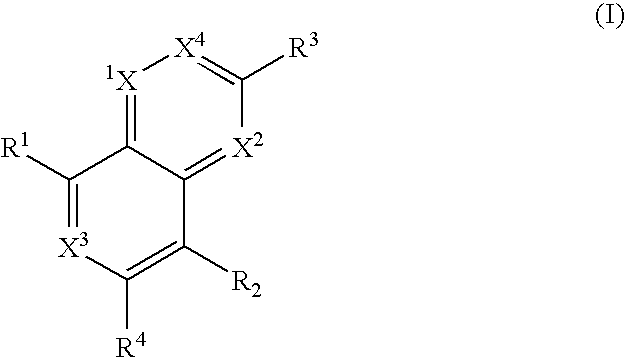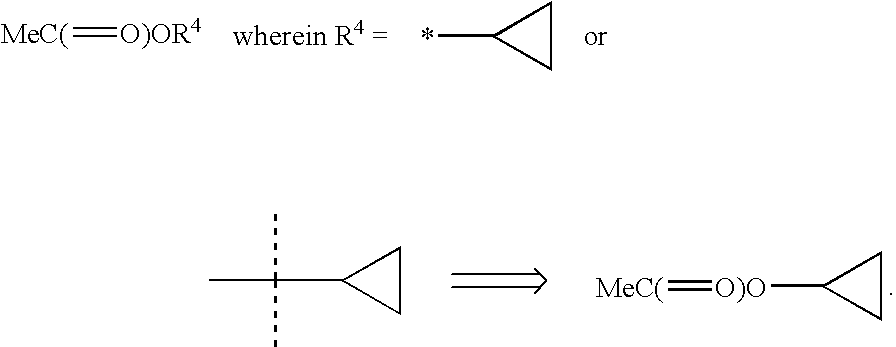Heterocyclic antiviral compounds
a technology of heterocyclic antiviral compounds and compounds, which is applied in the field of non-nucleoside compounds, can solve the problems of limited hcv prevention therapy, no preventive treatment of hepatitis c virus, and currently approved therapies, etc., and achieve the effect of inhibiting hcv replication and inhibiting hcv
- Summary
- Abstract
- Description
- Claims
- Application Information
AI Technical Summary
Benefits of technology
Problems solved by technology
Method used
Image
Examples
example 1
N-{4-[6-tert-Butyl-2-methoxy-8-(2-oxo-1,2-dihydro-pyridin-3-yl)-quinolin-3-yl]-phenyl}-methanesulfonamide (I-1)
[0174]
[0175]step 1—To a solution of 20a (10.0 g) and MeCN (200 mL) was added tri-(o-tolyl)phosphine (1.33 g), Pd(II)(OAc)2 (0.730 g), TEA (6.8 mL) and methyl acrylate (2.35 mL). The reaction was stirred overnight at 100° C. The reaction was cooled and concentrated in vacuo. The crude product was purified by SiO2 chromatography eluting with an EtOAc / hexane gradient (0% EtOAc from 0-5 min, 20% EtOAc from 5.5-15 min and 40% EtOAc from 15.5-30 min) to afford 3.02 g of 20b.
[0176]step 2—To a solution of 20b (6.73 g) and THF (150 mL) was added 6N HCl (150 mL) and the resulting solution was heated at 100° C. overnight. The solution was cooled and concentrated in vacuo. The reaction mixture was made basic with solid NaHCO3 and thrice extracted with EtOAc (3×150 mL). The combined extracts were washed with brine, dried (Na2SO4), filtered and concentrated in vacuo. The crude product wa...
example 2
N-{4-[7-tert-Butyl-5-(5-fluoro-2-oxo-1,2-dihydro-pyridin-3-yl)-quinoxalin-2-yl]-phenyl}-methanesulfonamide (I-2)
[0182]
[0183]step 1—To 4-tent-butyl-2-nitroaniline (31a, 5.0 g, 25.74 mmol) was added HOAc (40 mL). The reaction was heated to 50° C. until a clear orange-brown solution formed. The heating mantel was removed and bromine (1.46 mL, 28.32 mmol) was added carefully via syringe. The reaction was stirred 45 min more while cooling to RT then poured over ice (100 mL). The slurry was stirred with a glass rod and more solid precipitated out as the ice melted. The solid was collected on a glass frit and dried to afford 6.95 g (99%) of 31b.
[0184]step 2—To a solution of 31b (2.5 g, 9.15 mmol) in MeOH / H2O (100 mL / 25 mL) was added electrolytic iron (1.53 g, 27.46 mmol), and NH4Cl (1.47 g, 27.46 mmol). The reaction was heated at reflux for 4 h then filtered through glass fiber filter paper on a Buchner funnel to remove the iron. The solid was rinsed with MeOH and the filtrate was concentr...
example 3
N-{1-[7-tert-Butyl-5-(2-oxo-1,2-dihydro-pyridin-3-yl)-quinoxalin-2-yl]-piperidin-4-yl}-methanesulfonamide (I-3)
[0191]step 1—To a solution of 36a (0.100 g, 0.33 mol) and N-piperidin-4-yl methane sulfonamide HCl salt (37, 0.143 g. 0.66 mmol, CASRN 70724-72-0) in DMF (2 mL) was added DIPEA (0.2 mL, 1.00 mmol). The reaction was irradiated in the microwave synthesizer at 140° C. for 30 min. The reaction mixture was cooled, concentrated and adsorbed onto SiO2 and purified by SiO2 chromatography eluting with 5% MeOH / DCM to afford 0.102 g (69%) of N-[1-(5-bromo-7-tert-butyl-quinoxalin-2-yl)-piperidin-4-yl]-methanesulfonamide (42).
[0192]step 2—To a solution of 42 (0.040 g, 0.10 mmol) in MeOH and DCM (3 mL / 1 mL), was added Na2CO3 (0.029 g, 0.27 mmol), 30 (0.012 g, 0.11 mmol) and Pd(PPh3)4 (0.010 g, 0.010 mmol). The reaction was irradiated in a microwave synthesizer at 115° C. for 30 min. The reaction was cooled, concentrated and partitioned between EtOAc / H2O (25 mL / 25 mL). The aqueous layer w...
PUM
| Property | Measurement | Unit |
|---|---|---|
| temperature | aaaaa | aaaaa |
| temperature | aaaaa | aaaaa |
| temperature | aaaaa | aaaaa |
Abstract
Description
Claims
Application Information
 Login to View More
Login to View More - R&D
- Intellectual Property
- Life Sciences
- Materials
- Tech Scout
- Unparalleled Data Quality
- Higher Quality Content
- 60% Fewer Hallucinations
Browse by: Latest US Patents, China's latest patents, Technical Efficacy Thesaurus, Application Domain, Technology Topic, Popular Technical Reports.
© 2025 PatSnap. All rights reserved.Legal|Privacy policy|Modern Slavery Act Transparency Statement|Sitemap|About US| Contact US: help@patsnap.com



